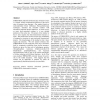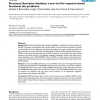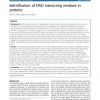22 search results - page 2 / 5 » PAR-3D: a server to predict protein active site residues |
APBC
2004
13 years 6 months ago
2004
THEMATICS (Theoretical Microscopic Titration Curves) is a simple, reliable computational predictor of the active sites of enzymes from structure. Our method, based on well-establi...
BMCBI
2008
13 years 5 months ago
2008
Background: The Structural Descriptor Database (SDDB) is a web-based tool that predicts the function of proteins and functional site positions based on the structural properties o...
BMCBI
2010
13 years 5 months ago
2010
Background: Small molecular cofactors or ligands play a crucial role in the proper functioning of cells. Accurate annotation of their target proteins and binding sites is required...
BIBM
2008
IEEE
13 years 11 months ago
2008
IEEE
Abstract—The exact relationship between protein active centers and protein functions is unclear even after decades of intensive study. To improve the functional prediction abilit...
BMCBI
2007
13 years 5 months ago
2007
Background: Relating features of protein sequences to structural hinges is important for identifying domain boundaries, understanding structure-function relationships, and designi...




